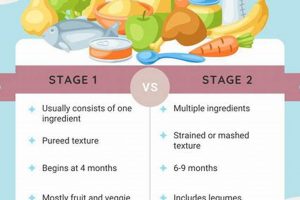Pureed infant nourishment repurposed as canine rewards represents a simple combination of ingredients. This practice involves utilizing commercially available or homemade preparations initially intended for human infants, offering them to dogs in controlled quantities as a palatable and easily digestible treat. For instance, a spoonful of unsweetened apple or sweet potato puree can be offered as a positive reinforcement during training sessions.
The appeal of such items stems from their gentle nature and ease of consumption, particularly beneficial for senior dogs or those with dental issues. Furthermore, these preparations are often perceived as a healthier alternative to heavily processed commercial treats, potentially providing essential vitamins and minerals in a readily accessible form. Historically, concerned owners have sought out human-grade food options to ensure the well-being of their canine companions, driving the adoption of this approach.
The following sections will delve into the advantages, potential risks, and practical considerations associated with integrating this type of supplementary feeding into a dog’s diet. This will encompass factors such as ingredient safety, portion control, and veterinary consultation.
Tips for Incorporating Pureed Infant Foods into Canine Treat Regimens
Integrating pureed infant foods as supplemental nourishment for dogs requires careful consideration. Prioritizing safety and nutritional balance is paramount.
Tip 1: Ingredient Verification: Thoroughly examine the composition of any pureed infant food before administration. Ensure the product is devoid of harmful additives such as xylitol, onion, garlic, or excessive salt. These elements can pose significant health risks to canines.
Tip 2: Gradual Introduction: Introduce the supplementary food incrementally. Begin with a small quantity, such as a teaspoon, and observe the dog’s reaction over a 24-hour period. Monitor for any signs of gastrointestinal distress, including vomiting or diarrhea.
Tip 3: Portion Control: Exercise strict portion control. Pureed infant foods should constitute only a small percentage of the dog’s overall dietary intake. Overconsumption can lead to weight gain or nutritional imbalances.
Tip 4: Opt for Single-Ingredient Options: Prioritize single-ingredient purees, such as sweet potato or pumpkin. This simplifies the process of identifying potential allergens or sensitivities. Multiple ingredient formulations increase the likelihood of adverse reactions.
Tip 5: Consultation with a Veterinarian: Seek professional guidance from a qualified veterinarian. Discuss the appropriateness of incorporating this type of supplemental feeding into the dog’s specific diet, considering factors such as age, breed, and existing health conditions. The veterinarian can provide tailored recommendations regarding appropriate quantities and suitable ingredients.
Tip 6: Homemade Options: When feasible, consider preparing purees at home. This allows for complete control over the ingredients, ensuring the absence of potentially harmful additives. Always utilize fresh, dog-safe produce when preparing homemade options.
Tip 7: Monitor Stool Consistency: Observe the dog’s stool consistency following the introduction of the supplementary food. Changes in stool consistency, such as increased softness or diarrhea, may indicate intolerance or overfeeding. Adjust the quantity accordingly or discontinue use.
By adhering to these guidelines, owners can safely incorporate pureed infant foods into their canine’s regimen. However, remember that individual dietary requirements vary; personalized veterinary advice remains essential.
The following section will address common concerns and frequently asked questions regarding the use of these food items as canine treats.
1. Ingredient Safety
The paramount concern when employing infant nourishment as canine treats centers on ingredient safety. The causal relationship between unsafe ingredients and adverse canine health outcomes dictates meticulous scrutiny of product labels. Infant formulations, while generally safe for human consumption, may contain substances toxic to dogs. Xylitol, a common artificial sweetener, serves as a salient example; even small quantities can induce hypoglycemia, seizures, or liver failure in canines. Therefore, ensuring the absence of such harmful compounds represents a critical component of responsible treat selection.
The practical significance of understanding ingredient safety extends beyond simply avoiding explicitly toxic substances. Some ingredients, while not immediately lethal, can contribute to chronic health issues. For example, excessive sodium content, often present in processed foods, can exacerbate underlying heart conditions in susceptible dogs. Similarly, certain preservatives or artificial colorings may trigger allergic reactions or digestive upset in sensitive individuals. Careful attention to detail is therefore crucial when selecting appropriate supplements.
In summary, ingredient safety constitutes a foundational pillar in the judicious use of pureed infant foods as canine rewards. Vigilant examination of product compositions, coupled with a comprehensive understanding of canine dietary sensitivities, is essential to prevent potential health complications. Furthermore, veterinary consultation should be pursued to create balanced diets that promote canine well-being. This thoughtful approach mitigates risk and strengthens the basis for a safe and effective supplementary feeding strategy.
2. Nutritional Benefits
The nutritional advantages of employing infant nourishment as supplemental canine food are contingent upon several factors. Selecting purees based on their inherent nutritional profile presents a key aspect. The goal is to augment a dog’s existing diet with readily digestible vitamins and minerals, rather than substituting essential components of their standard meals.
- Vitamin and Mineral Supplementation
Specific purees, such as sweet potato or pumpkin, offer notable levels of Vitamin A, potassium, and fiber. These nutrients can be particularly beneficial for dogs with specific dietary deficiencies or digestive issues. For instance, Vitamin A supports vision and immune function, while potassium contributes to electrolyte balance. Fiber aids in regulating bowel movements, alleviating constipation or diarrhea.
- Digestibility and Bioavailability
The pureed consistency of infant nourishment renders nutrients more easily digestible and bioavailable for canines, especially senior dogs or those with compromised digestive systems. The breakdown of complex carbohydrates and proteins during the pureeing process simplifies nutrient absorption. This is beneficial for maximizing the nutritional value derived from the supplemental food.
- Limited Ingredient Options
The availability of single-ingredient purees mitigates the risk of allergic reactions or sensitivities. This is in contrast to many commercial canine treats that contain numerous additives and preservatives. By selecting single-ingredient options, owners can more readily identify and avoid potential allergens.
- Hydration Support
The high moisture content of pureed infant food can contribute to improved hydration, particularly relevant for dogs that do not readily consume sufficient water. Adequate hydration supports kidney function and overall physiological well-being. This is more prominent during warmer weather.
It remains essential to emphasize that while certain preparations offer potential nutritional contributions, pureed infant food should never supplant a balanced, complete canine diet formulated by a veterinarian or certified canine nutritionist. The purpose of this supplementary nourishment should be precisely to fill nutrient deficits or meet particular dietary needs, not to constitute the primary source of caloric or nutritional intake.
3. Digestibility
Digestibility represents a critical factor in evaluating the suitability of pureed infant nourishment for canine consumption. The ease with which a dog’s digestive system can process and absorb nutrients from a given food source directly impacts its nutritional value and overall well-being.
- Reduced Digestive Burden
The manufacturing process involved in creating infant preparations often entails pre-processing of ingredients, resulting in smaller particle sizes and partially broken-down macromolecules. This pre-digestion reduces the workload on a dog’s gastrointestinal tract, which may be particularly advantageous for senior canines or those with pre-existing digestive sensitivities. Example: The starch in sweet potatoes is already partially hydrolyzed, easing digestion.
- Enhanced Nutrient Absorption
The pureed consistency facilitates increased surface area for enzymatic action within the digestive system, thereby promoting more efficient nutrient absorption. This is especially relevant for fat-soluble vitamins and essential minerals, which require proper emulsification and micelle formation for optimal uptake. Example: Vitamin A from carrot puree is absorbed more readily.
- Lower Risk of Gastrointestinal Irritation
Compared to some commercial canine treats that contain complex carbohydrates, artificial additives, or high levels of insoluble fiber, pureed infant nourishment typically presents a lower risk of inducing gastrointestinal irritation or allergic reactions. The simplified composition and lack of extraneous ingredients minimize potential triggers for digestive upset. Example: Single-ingredient fruit purees often avoid common grain allergens.
- Suitability for Specific Medical Conditions
The easily digestible nature of this food category can be beneficial for dogs recovering from gastrointestinal surgeries, experiencing appetite loss due to illness, or suffering from malabsorption syndromes. These canines often require easily tolerated sources of nutrition to support healing and maintain body weight. Example: Post-operative feeding protocols may incorporate easily digested purees.
Consequently, the increased digestibility inherent in many preparations makes them a potentially viable supplementary food option for dogs. However, the ultimate determination of suitability should always rest on a comprehensive assessment of the individual dog’s health status, dietary needs, and veterinary consultation, avoiding solely relying on general benefits.
4. Portion Control
Portion control assumes paramount importance when incorporating pureed infant nourishment into a canine’s dietary regimen. The supplemental nature of these foods necessitates strict adherence to recommended quantities to prevent adverse health outcomes.
- Caloric Density and Weight Management
Infant preparations, while often perceived as healthy, can exhibit a relatively high caloric density due to concentrated sugars or fats. Unrestricted administration of these food items may contribute to excessive caloric intake, resulting in weight gain and subsequent health complications such as obesity, joint problems, and cardiovascular disease. Controlled portions mitigate the risk of overfeeding and associated ailments. For instance, a small breed dog requiring 200 calories daily should receive only a tiny amount of a high-calorie fruit puree, preventing excess calorie consumption.
- Nutritional Imbalance and Dietary Displacement
The disproportionate administration of pureed infant nourishment can displace essential nutrients derived from a balanced canine diet. If given in excessive quantities, these supplements may reduce the dog’s appetite for its regular food, leading to deficiencies in protein, essential fatty acids, and other crucial nutrients. Portions should complement, not substitute, balanced canine feed, in order to prevent nutritional deficits that impact health.
- Gastrointestinal Upset and Digestive Overload
Introducing large quantities of pureed nourishment, particularly those high in fiber or specific sugars, can overwhelm the canine digestive system, leading to gastrointestinal distress. Symptoms may include diarrhea, vomiting, abdominal discomfort, and flatulence. Gradual introduction and controlled portion sizes promote optimal digestion and minimize the risk of digestive upset. Monitoring stool quality after controlled food introduction ensures better digestive well-being.
- Ingredient Sensitivities and Allergic Reactions
Careful portioning is also valuable in identifying ingredient sensitivities or allergic reactions within a new food. If a dog reacts adversely to a baby food puree, but had only consumed a very small quantity, the impact is smaller than if the dog was over fed the new product.
In summary, diligent portion control constitutes a cornerstone of responsible use of infant nourishment in canine diets. Understanding caloric density, preventing nutritional imbalances, mitigating gastrointestinal distress, and identifying sensitivities are interconnected facets. Responsible owners need to take these into consideration.Veterinary guidance is recommended to establish appropriate portion sizes and maximize the potential benefits of supplementation while minimizing potential risks.
5. Allergen Awareness
The integration of infant nourishment into a canine diet necessitates stringent allergen awareness protocols. The potential for adverse reactions resulting from undetected allergens constitutes a significant risk. Allergic responses manifest through various symptoms, ranging from mild dermatological irritation to severe anaphylaxis. Therefore, a thorough understanding of common canine allergens and meticulous scrutiny of ingredient lists are essential when considering such products. For instance, many formulations contain grains or soy, known allergens for certain dogs. Failure to recognize these components can trigger adverse reactions, necessitating veterinary intervention.
Practical application of allergen awareness involves a systematic approach. Initially, obtaining a comprehensive understanding of the dog’s prior allergic history, through veterinary records or owner observations, is crucial. Subsequently, a detailed examination of the infant food’s ingredient list should be conducted to identify potential allergens. This is followed by a gradual introduction of the product, coupled with vigilant monitoring for any signs of allergic reaction, such as itching, hives, facial swelling, or gastrointestinal distress. Documenting reactions and their relationship to specific ingredients aids in future avoidance strategies. If, for example, a dog displays pruritus following ingestion of a wheat-containing product, wheat should be eliminated from its diet.
Effective allergen awareness represents a crucial component of responsible supplementary feeding practices. It presents challenges due to the potential for cross-contamination during manufacturing, or inaccurate labeling. Overcoming these challenges requires proactive investigation and communication with manufacturers, when appropriate. Ultimately, prioritizing awareness facilitates informed decision-making and contributes significantly to maintaining the health and well-being of the canine population.
6. Veterinary Consultation
The introduction of pureed infant nourishment into a canine’s diet, while seemingly benign, necessitates prior consultation with a qualified veterinarian. This professional interaction serves as a critical safeguard, mitigating potential health risks and ensuring the appropriateness of such dietary supplementation. Veterinary assessment considers the individual dog’s age, breed, weight, existing health conditions, and current dietary needs. For example, a dog with renal insufficiency requires a diet specifically formulated to minimize phosphorus intake; adding baby food without veterinary approval could exacerbate the condition. The consultation addresses the suitability of specific ingredients and establishes appropriate portion sizes, avoiding potential nutritional imbalances. Therefore, neglecting this preliminary step represents a potential breach of responsible pet ownership, increasing the risk of adverse health outcomes.
The practical significance of veterinary input extends beyond simple risk mitigation. A veterinarian can provide informed recommendations regarding optimal ingredient selection, tailoring the supplementary diet to address specific nutritional deficiencies or support treatment plans. For instance, a dog recovering from surgery might benefit from a puree rich in easily digestible protein, while a senior dog experiencing constipation may require a fiber-rich option. Veterinary expertise also aids in identifying potential allergens or intolerances, preventing adverse reactions. Furthermore, the veterinarian can monitor the dog’s response to the dietary change, adjusting the regimen as needed based on objective parameters, such as bloodwork and physical examination findings. A veterinarian can identify subtle changes in the animal’s health that the owner might not notice until they are serious.
In summary, veterinary consultation forms an indispensable component of responsible canine dietary management, particularly when considering the integration of unconventional food sources. It is a preventive measure aimed at safeguarding canine health, optimizing nutritional intake, and preventing complications. Ignoring this essential step introduces avoidable risks and potentially compromises the well-being of the animal. This thoughtful approach ensures the safe and effective implementation of supplementary feeding strategies. The informed application of this will also create better habits with the dog in the long run.
Frequently Asked Questions
This section addresses common inquiries regarding the safety, suitability, and appropriate usage of processed infant nourishment as supplemental canine treats. These answers reflect general guidelines and should not replace veterinary consultation.
Question 1: Is it safe to feed dogs commercially prepared baby food?
Commercially prepared infant nourishment can be safely administered to dogs, provided that the product does not contain xylitol, onion, garlic, or other substances toxic to canines. Careful scrutiny of ingredient labels is mandatory.
Question 2: What are the potential benefits of offering pureed infant preparations to dogs?
Potential benefits include enhanced digestibility, vitamin and mineral supplementation, suitability for dogs with dental issues, and increased palatability for those with diminished appetites. These benefits remain contingent upon appropriate ingredient selection and portion control.
Question 3: Can baby food replace a dog’s regular food?
No, processed infant nourishment should not replace a dog’s complete and balanced commercial or home-prepared diet. It functions solely as a supplementary treat and should not constitute a primary source of nutrients or calories.
Question 4: What quantity of this food is appropriate for dogs?
The appropriate quantity varies based on the dog’s size, age, breed, activity level, and overall health status. As a general guideline, treats should not exceed 10% of the dog’s daily caloric intake. Veterinary consultation is advisable for determining precise portion sizes.
Question 5: Are there specific types of baby food to avoid?
Products containing artificial sweeteners (especially xylitol), onion, garlic, excessive salt, or potentially allergenic ingredients (e.g., dairy, soy) should be strictly avoided. Prioritize single-ingredient purees to minimize the risk of adverse reactions.
Question 6: How can owners identify potential allergic reactions to novel baby food?
Owners should introduce new purees gradually, monitoring for signs of allergic reaction, such as itching, hives, facial swelling, vomiting, or diarrhea. If any adverse symptoms manifest, discontinue use immediately and consult a veterinarian.
The information presented in this FAQ section serves solely as a general guide. It is emphasized that responsible canine dietary management necessitates individualized assessment and professional veterinary advice.
The following section will provide a summary and concluding remarks regarding the information provided within this document.
Conclusion
This exploration of baby food dog treats has elucidated the nuanced considerations inherent in their utilization as a canine dietary supplement. Key points include the paramount importance of ingredient verification, allergen awareness, and the necessity of veterinary consultation. While offering potential benefits such as enhanced digestibility and targeted nutrient supplementation, the administration of pureed infant nourishment necessitates meticulous attention to portion control and potential risks. The responsible application of such supplements requires careful consideration of each animal’s individual health needs, and awareness of contraindications.
Ultimately, the decision to incorporate baby food dog treats into a canine regimen should rest upon informed judgment and veterinary guidance. The information presented herein underscores the significance of prioritizing animal welfare through evidence-based practices and responsible pet ownership. Further research into the long-term effects of this feeding strategy remains warranted, solidifying the need for continuous vigilance and informed decision-making.







